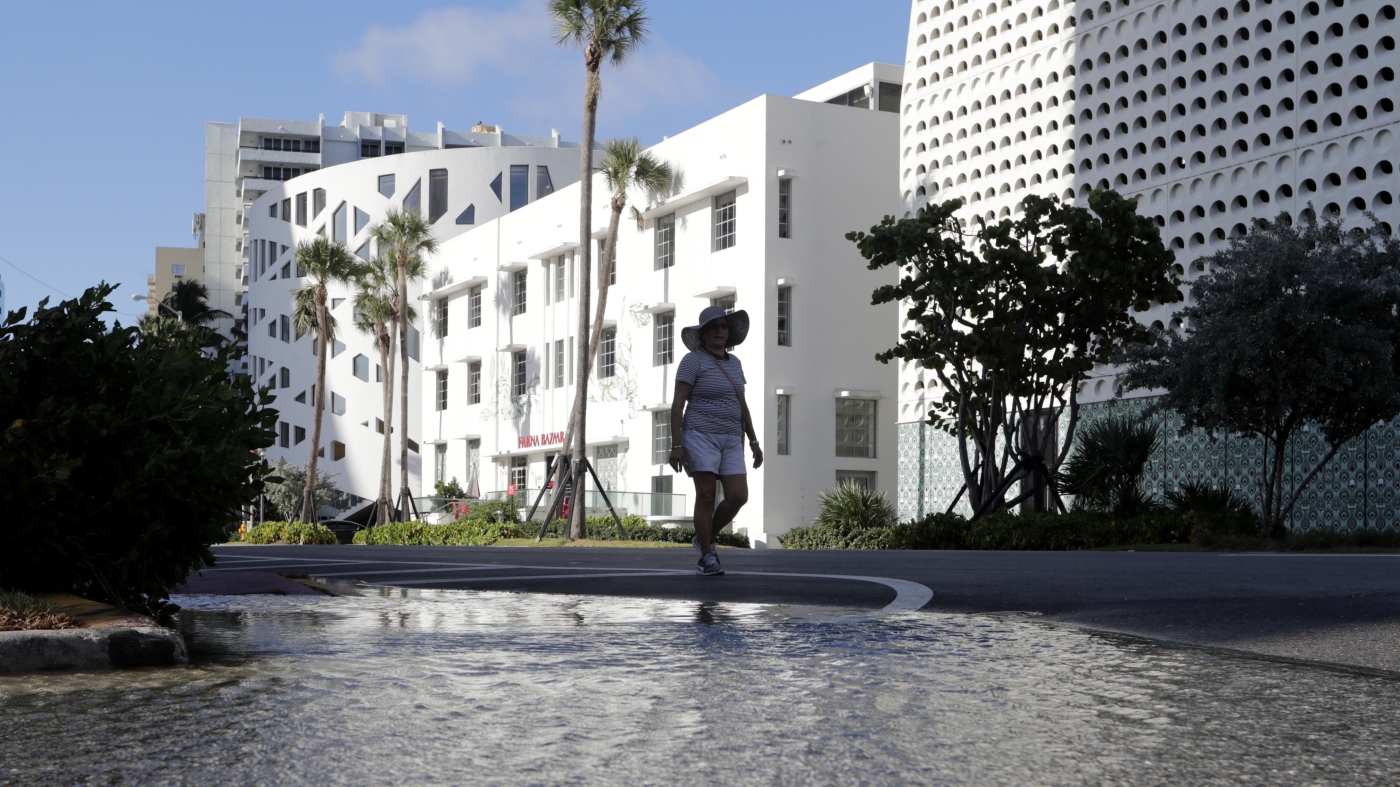
A woman walks along a flooded street caused by a king tide in Miami Beach, Fla. in 2019. So-called sunny day floods are getting more common in many coastal areas as seas rise due to human-caused climate change.
Lynne Sladky/AP/AP
hide caption
toggle caption
Lynne Sladky/AP/AP
Coastal flooding from high tides is getting more common in most parts of the United States, as climate change causes sea levels to rise.
Millions of people are affected by so-called sunny day flooding each year, according to a new report by the National Oceanic and Atmospheric Administration (NOAA). On average, the U.S. now experiences five extra days of high-tide flooding each year compared to the year 2000.
“Over the past year we’ve seen record coastal flooding,” says Nicole LeBoeuf, the director of the NOAA National Ocean Service.
In the last year, St. Petersburg, Fla., Atlantic City, N.J., Charleston, S.C. and more than 30 other places tied or broke their records for the number of high-tide flood days. Galveston, Texas, which consistently sees some of the most severe and frequent high-tide flooding of any city in the U.S., experienced 23 days of high-tide flooding last year.
The costs of high-tide flooding are enormous. Even a few inches of water can make neighborhoods inaccessible to some residents, including those who use wheelchairs or rely on strollers to transport young children. And standing water can also snarl commutes, block emergency vehicles and cause secondary flooding if sewers back up into buildings or overflow into natural bodies of water.
“People living in the [Florida] Keys or Annapolis or Norfolk – they’re facing traffic delays dropping their kids off at school or getting to work because there’s water that’s flooding the streets,” says Karen Kavanaugh, an oceanographer at NOAA. High-tide flooding can also force businesses to close, and even a small amount of saltwater flooding can erode underground pipes and damage vehicles.
Sea levels don’t rise at the same rate everywhere, and the effects of high-tide flooding are even more pronounced in places where sea levels are rising most rapidly, the report notes. In the last 25 years or so, the number of days with high-tide flooding has increased by a whopping 250% or more in many regions, including along the Gulf of Mexico, and in the Mid-Atlantic and the Pacific Islands.
“Decades of sea level rise are catching up,” says William Sweet, an oceanographer at NOAA.
And there’s no reprieve in sight, as global temperatures continue to increase and sea levels continue to rise. The average number of annual high-tide flood days for the U.S. is expected to top 45 days by mid-century. Local governments in many coastal areas are racing to upgrade infrastructure to withstand salt water, improve sewers and drainage and budget for the costs of damage and disruption from high-tide flooding.
While high-tide flood forecasts do not consider flooding from storms, the same sea level rise that is driving more sunny day floods also exacerbates coastal storm flooding, as residents of Florida, Georgia and South Carolina experienced following Hurricane Debby. The storm came ashore in Florida as a weak Category 1 hurricane and was quickly downgraded to a Tropical Storm, but storm surge and rain has nonetheless caused catastrophic flooding across the Southeast, in part because rising seas mean the ocean is closer to the built-up coastline.
“These areas are already under the thumb of sea level rise, making the combination of Debby’s storm surge and rainfall potentially catastrophic,” LeBoeuf explains.
